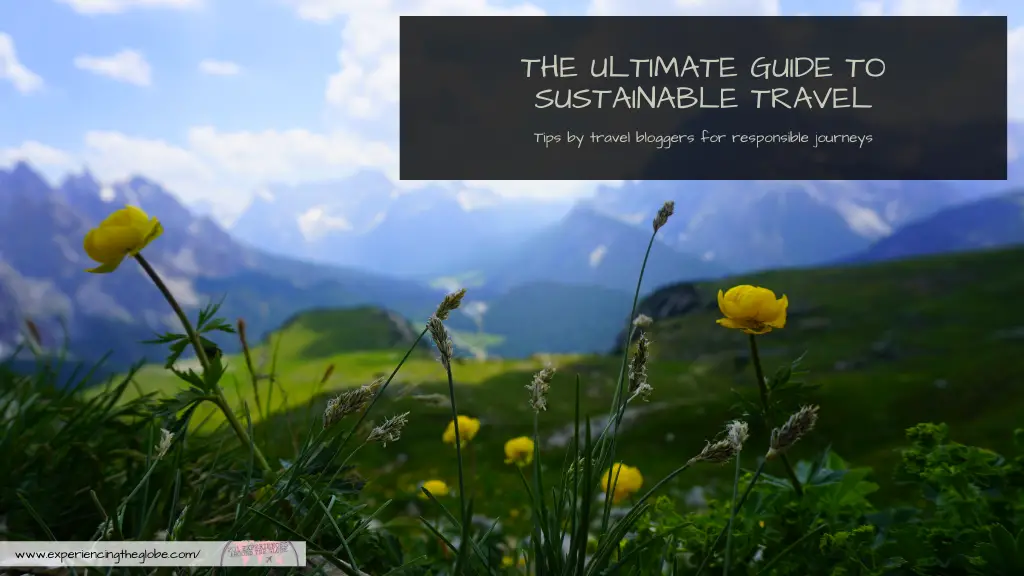

It pains me to say it, but let’s face it, traveling is not the most sustainable activity on earth. We are leaving a carbon print in each trip. That means that, if we want to see the rest of the world, we have a duty to start acting more responsibly. To make it easier for you, my dear reader, I asked fellow travel bloggers for their best sustainable travel tips and the answers were amazing! You have in front of you everything you need to know about traveling sustainably, so now all you need to do is start taking action! Remember that even if you only adopt a few of these suggestions, you’ll be contributing (although –as in most things in life– the more the merrier!).
We live in a wonderful time, where traveling is accessible to more and more people. As much as I advocate for people to travel more, there are consequences that come with this. A lot of people feel entitled, which translate into disrespecting the culture of the place they’re visiting, and the planet itself, by not being conscious of the damage even the smallest of actions can have.
Thankfully the concept of sustainable travel is becoming more known, and people are taking action into making their travels more responsible.
First thing first: What is sustainable travel?
In very simple words, it’s long term tourism that doesn’t affect the environment. In a few more words, as the NGO Sustainable Travel International puts it, it means to safeguard nature, combat climate change, empower communities and tackle waste and pollution so we protect the places we love.
You’ll interchangeably hear the concepts of “green travel”, “responsible travel” and “eco-conscious travel” –it’s important to know that all of them are different, but part of sustainable tourism, which not only involves taking care of nature. Actually, it’s based on three pillars: environmental, social and economic. This tells us that to be a sustainable traveler we need to have a positive impact and leave smaller energy footprints, be aware of the local culture, and help the local communities to develop.
In today’s world, there’re over 1.4 billion people traveling each year. That’s great! Tons of people are seeing the world, are experiencing new cultures, and learning about the places they’re visiting. But global tourism also means overtourism. This is such a new phenomenon that the word is not even in the dictionaries. It means that an excessive number of tourists visiting a popular destination results in the damage of natural, historical and cultural environments, making the quality of life of the locals poorer (according to the Oxford Dictionary shortlist). Ouch.
However, tourism is really important to small communities around the world, so don’t get discouraged! The point is not to stop traveling (because I know I couldn’t!) but to travel in a sustainable way.
I want to be a sustainable traveler: What can I do?
I asked a group of amazing fellow travel bloggers for their best advice, so together with mine, I created the ultimate list of sustainable travel tips. The more you adopt, the better, but keep in mind that even small changes add up and make a difference. Join the sustainable travel movement!
Items for sustainable travel
A reusable water bottle
By Stephanie from Sofia Adventures
One thing that travelers can do to make their trips more sustainable is to stop using plastic bottles while on the road. Because you’re not in control of when thirst will come, travelers often find themselves having to reach for a plastic bottle of water much more often than at home.
A great way to combat this is to bring a reusable water bottle. If you’ll be traveling anywhere where the water supply isn’t drinkable, you can buy one with a built-in filter so you can still use your own water bottle and drink tap water. We even suggest packing one for places like Greece where the water is drinkable in most places but there are islands where it’s better not drinking tap water.
Besides saving money and reducing your plastic use, this also ensures you’ll drink more water on your trip. It’s easy to get dehydrated when you’re out sightseeing all day, and this will make sure you always have clean, refreshing water within arm’s reach!
A water filter
By Steph from Worldly Adventurer
If you’re traveling in a destination where tap water isn’t safe to drink, the best way to reduce your environmental impact is to invest in a portable water filter or sterilizer. This means you no longer have to buy expensive and wasteful single-use plastic bottles of water.
I’ve tried a number of different options and each and every time I come back to the Steripen Adventurer. Not only is it lightweight and supremely easy to use, the batteries on this thing last forever –well, for a good couple of months at least. It takes just 90 seconds to sterilize a liter of water, which you do by inserting the device into the water bottle and stirring continually until it indicates with its clever light system that you need to stop.
I’ve used the Steripen throughout my travels in South America, allowing myself access to safe and clean water literally at the push of a button. I’ve also saved myself hundreds of dollars by not buying water and I’m safe in the knowledge that I’ve reduced my environmental impact along the way.
A more budget-friendly option that is also amazing is a Life Straw.
A reusable shopping bag
By Matilda from The Travel Sisters
A very easy way to be a sustainable traveler is to pack and carry a reusable shopping bag with you when in order to avoid using plastic bags. Instead of taking a plastic bag every time you shop for food, souvenirs or anything else you might buy on your trip, you can use a reusable bag to carry back your purchases.
In addition of being an eco-friendly choice, using a reusable shopping bag is also practical and will likely save you money in the long run. More and more places charge customers for plastic and paper bags, so by having your own bag when you shop you can avoid paying extra for unnecessary bags. Reusable bags are also more durable, so you don’t have to worry about flimsy plastic bags ripping apart and your purchases falling to the ground. The shopping bag I use folds into a small pouch, which means I can throw it in my purse or backpack and pull it out when I make purchases. It’s definitely a travel essential for me!
Solid toiletries
By Rohan from Travels of a Bookpacker
Solid toiletries are an amazing eco-friendly travel option and are becoming very popular in many countries making them easy to buy, both before or during your trip. The movement started with shampoo but now there is a huge range of solid products available such as conditioner, body butter, face wash and body wash. The main reason to switch to solid toiletries is the reduction in plastic waste as they usually come wrapped in paper or cardboard. But there are some other benefits as well.
Solid toiletries are usually made of natural or eco-friendly ingredients meaning that no harsh chemicals are going down the drains. This is especially important when traveling to countries with limited or no wastewater systems, and it also makes them perfect for camping. Because they are solid there are no hassles taking them in your hand luggage. They can also work out to be more economical than their liquid counterparts as one bar lasts up to six months.
Reef-friendly sunscreen and eco-friendly bug spray
By Erika from Erika’s Travelventures
Some of the most beautiful places we travel to are some of the most ecologically fragile. Not only do we need to be conscious of what we consume and discard, we need to keep in mind what chemicals we are spreading with our presence. Every sustainable packing list should include reef-friendly sunscreen and eco-friendly bug spray, so we can make sure that the nature around us, and our bodies, stay healthy.
Reef-Friendly Sunscreen – Snorkeling or diving in crystal clear water is a favorite traveler’s pastime. Sunscreen is a staple for these activities to protect your skin, but know that whatever you put on your skin before getting in the water is likely to wash off and mix with it. Corals, as well as the small fish that call coral reefs home, are sensitive to these washed-off chemicals from many regular sunscreens. The chemicals can even accelerate coral bleaching. To travel sustainably, look for “Palau Reef Safe” rating, which means the sunscreen meets the world’s strictest standards for being reef and marine safe.
Eco-Friendly Bug Spray – Many of the most popular travel destinations, like Southeast Asia and Latin America, are home to stubborn flocks of mosquitoes. Bug spray is a must-have item, but it’s important for the earth and for your own health to choose one that isn’t filled with chemicals. Bug spray made of natural ingredients has slowly gained popularity because it reduces the exposure of humans –and of the flora and fauna of the environment around you– to unnecessary chemicals. Use bug spray made from natural ingredients to reduce your chemical footprint. Ingredients like lemongrass, citronella, lemon-eucalyptus, and peppermint naturally repel mosquitoes and other bugs.
Reusable containers
By Wendy from The Nomadic Vegan
A collapsible container is a great thing to pack if you’re aiming to be a zero waste traveler, which means avoiding wasteful packaging and single-use plastic containers. If you’re ordering food from a takeaway shop or a street food stall, you can ask the vendor to put your order in the tupperware instead of the single-use containers they normally use. It’s equally handy as a doggy bag if you can’t finish your meal at a restaurant and want to take away your leftovers.
If you prefer, you could carry a glass mason jar instead, but you may find this to be less practical. Glass is heavy, and it can also break, whereas tupperware is much lighter and it takes up less space if you get the collapsible kind. If you’re trying to avoid plastic completely, you could bring a stainless steel container instead, like the tiffin tins common in India. What’s most important, though, is not what material your container is made of, but rather remembering to carry a reusable container in the first place.
Stainless steel straws and bamboo cutlery
By Cath from Passports and Adventures
As a family we are becoming more conscious of our carbon footprint and to try to improve our ability to travel sustainability, we have taken some steps at home and while traveling to become more eco-conscious. One way we are doing that is by trying to become plastic free at home and we are doing this by swapping plastic for more sustainable alternatives.
We have purchased a set of stainless-steel straws which I now carry everywhere we go. This means that we can refuse plastic straws in restaurants, cafes and bars, and use our reusable straws. They come with a cleaning pipe and drawstring bag so are truly reusable and sustainable.
Another place where we have made the swap is by purchasing some bamboo cutlery. Some eateries around the world provide single-use disposable plastic cutlery with meals. The same is true of many airlines that serve meals, particularly on long-haul flights. By bringing a set of bamboo cutlery, we can again refuse the single-use plastic options offered and use something that is reusable and sustainable.
Simple swaps from plastic to stainless-steel straws and bamboo cutlery can help anyone travel more sustainably.
Scrubba wash bag
By Nicole from The Passport Kids
One of the best tips for sustainable travel that we used while traveling for a year as a family was to bring a product called a Scrubba wash bag. This product lets you wash any essential clothes needed to be properly cleaned without having to do a full load of laundry for a few items. You simply add a little bit of water, biodegradable soap and use this sealed bag to scrub your clothes, then rinse them and hang to dry. A quick solution to washing clothes while using minimal amounts of water. No more having to do a full load for a few shirts and underwear. It folds up easily and takes up barely any space in your luggage.
This bag can also double as a waterproof bag for your valuables at the beach, to keep sand and water out too! Using one product to solve two problems while traveling, that’s what I call sustainable.
Portable solar panels for camping
By Kyle from Via Travelers
My favorite way to travel sustainably is by using portable solar panels during camping. Solar panels are a great way to remain connected to your precious electronics while generating and consuming power no matter your location. The cost of solar panels has declined dramatically in the past few years thanks to technological innovations and improvements in the procurement process. Solar panels are everywhere. You likely just don’t notice them.
Portable solar panels don’t need to be a large-scale solar farm to be effective. If you are an avid camper, you need to look into using portable solar panels. You will likely have a digital camera, or some sort of video recording device and solar panels can be a great way to keep your electronics charged and good-to-go to capture your next travel experience. Portable solar panels are foldable, which makes them incredibly easy to pack and take along with you, no matter if you are flying or driving. You won’t have to pay for power and can use the generation to power a battery pack that can be used for later, which will save you some extra money as a travel hack.
Menstrual cup
By Kaisa from Glam Granola Travel
Attention all period-having travelers! If you are not already using the menstrual cup, let me tell you why you should consider converting. My menstrual cup was an absolute game changer when it came to reducing waste and saving money on the road, and I’ve never looked back.
Think about your menstrual pads and tampons. Think about the boxes they come in, the plastic they’re wrapped in, and how many of them you go through every month. Now, multiply that waste by a lifetime. Yikes.
The menstrual cup only needs to be purchased once every couple years, and you can use it every month with zero waste (and zero cost beyond the initial cost of purchase). It’s discreet, effective, easy, affordable, environmentally savvy… need I go on?
Switching to the menstrual cup from traditional wasteful menstrual products was one of the best decisions I’ve made since I started traveling. The planet and your wallet will thank you!
Sustainable behaviors
Travel off season
By Maggie from The World Was Here First
If you want to find a way to minimize your impact when traveling, then visiting destinations –especially popular destinations– off season is a great starting place. Not only is it generally cheaper to travel off season but distributing tourist arrivals more equally can substantially lessen the burden that tourists tend to have on places.
Many destinations across the globe are struggling with the effects of overtourism and this is just exacerbated when a vast majority of visitors arrive during the peak 3 months of the year. This means that locals who rely on the tourism industry for employment are insanely busy for a few months and then have to make that money stretch once the tourist crowds have subsided. Traveling off season can help support locals who live in the place you’re visiting beyond the tourist season, and you’re much more likely to get an authentic experience while you’re there as well.
For example, visiting popular European destinations like Croatia, Italy or Spain in the winter months can also allow for more flexibility for travelers, along with lower prices. Because of less tourist demand, you can book accommodation and tickets to popular attractions later in advance and often at lower prices. This makes traveling in the off season a win-win for both the local economy and for you as a traveler.
Pack light
By Graham from My Voyage Scotland
When traveling, pack light. This will take some weight off your shoulder but surprisingly it will also decrease your carbon footprint.
The logic behind this tip is simple. Packing lighter means a lighter plane. A lighter plane uses less fuel. Admittedly, on your own this won’t do much, but if everyone traveling in an airplane was weight-conscious when packing for a flight, the carbon footprint of flying would be reduced.
This isn’t only relevant for flying. Traveling lighter in a taxi, bus or other forms of transport will ultimately cut your carbon footprint. As the old saying goes: “every little helps”.
Invest in a decent lightweight jacket. Also, look at Merino wool, which has a really good “warmth to weight” ratio. In general, think smart when packing and consider doubling up items of clothing. Got a decent pair of walking shoes that you can also wear when you need to dress up? Great! You’re on the right track.
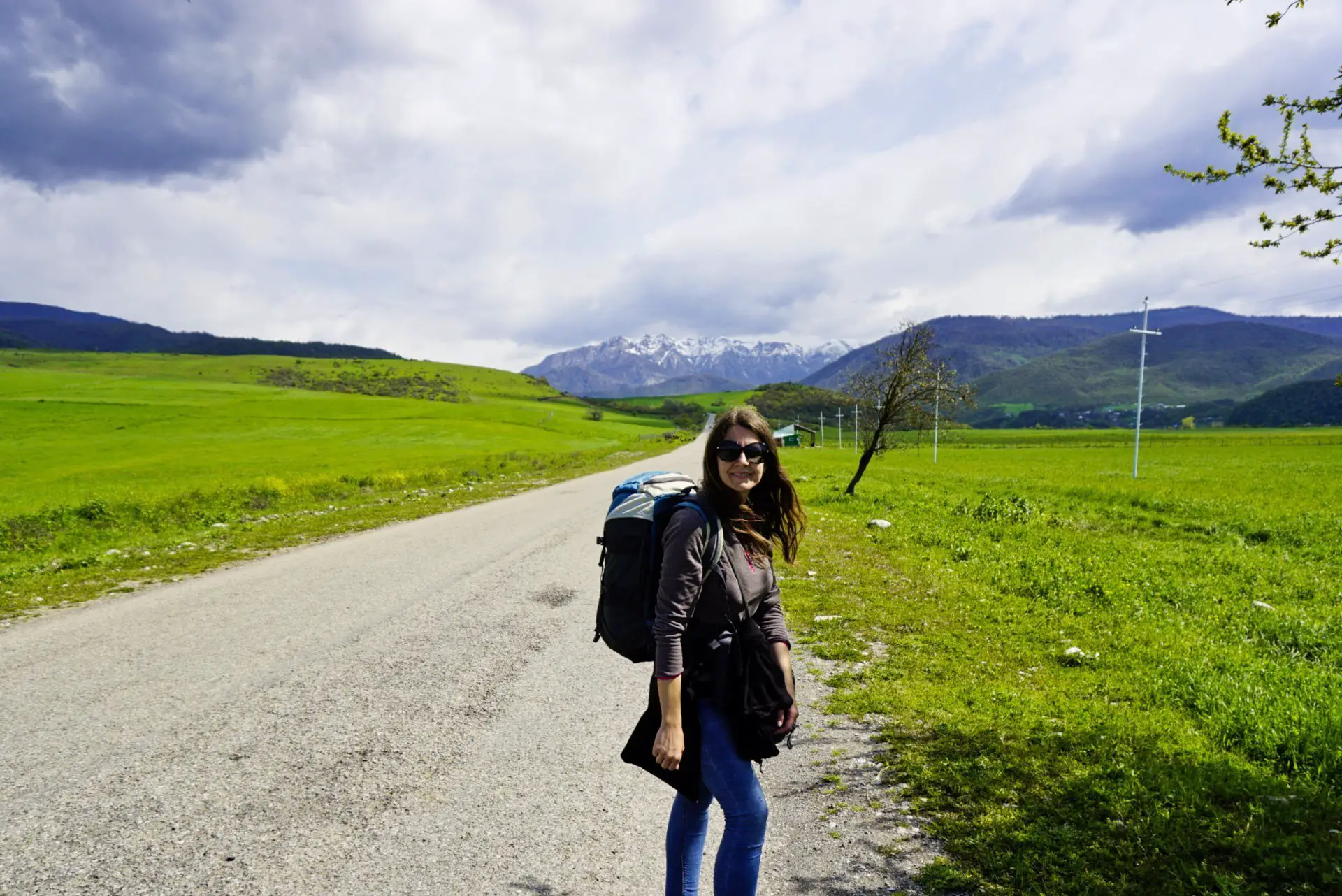
Adopt a vegan diet
By Anna from My Travel Scrapbook
Adopting a vegan diet is a great way to travel more sustainably! As travelers, we tend to have higher carbon footprints than others and one way to minimize it is to adopt a vegan diet. The amount of land and water needed to produce meat is much greater than for plants. Even consider adopting a vegetarian diet as the carbon footprint of a vegetarian is about half that of a meat-lover’s diet.
Furthermore, by adopting a vegan diet you are helping the environment in other ways. You are not supporting overfishing by eating plant-based. Additionally, the recent images of the amazon on fire shows how much the meat industry is contributing to deforestation. Did you know that all the livestock in the world cause more air pollution than all the cars, buses, planes, ships and other modes of transportation in the world combined?
If you are a nature loving traveler who is conscious about their impact on the environment, consider traveling as a vegan or making a few swaps each week. Traveling as a vegan also takes you to wonderful Buddhist temples with vegan restaurants in Asia or wonderful vegan afternoon teas in the UK. What you choose to consume directly impacts the environment whether that is food, fashion or transport. Eating a plant-based diet is a great way to travel more sustainably! Here are a few vegan travel quotes to inspire your first vegan trip!
RELATED POST → Vegan travel: Sustainability and the most veg friendly destinations
Be a slomad
By Michael from Brent and Michael are going places
Do yourself –and the planet– a favor: be a “Slomad”. There’s been a lot of talk lately about the resources of travel, especially millions of people zipping all over the planet by plane. One international flight can generate as much greenhouse gas as an entire year of driving a car.
As a digital nomad, it’s awesome to live in lots of different countries. My husband and I love it. What’s not so awesome? The greenhouse-spewing flights many digital nomads take getting from place to place.
So how to be a nomad, but with less of an impact? Be a slomad, which is short for “slow nomad.” Rather than breeze through a dozen countries in a year, we try to limit ourselves to three or four destinations. And we mostly stick to one part of the world. We also try to travel by train and boat as much as possible.
Last year, we lived in Miami, Florida; Birgu, Malta; Matera, Italy; and Bansko, Bulgaria. Malta, Italy and Bulgaria are all relatively close together, which helped limit the amount of CO2 we pumped into the atmosphere. And we went by boat from Florida to Europe.
In addition to shrinking our carbon footprint, being a slomad lets us to really get to know a place –both the locale and the people who live there. When we do finally leave a place, it feels like we’re really lived there. Like it was our home. And we also feel better about doing a little less damage to this planet we love so much.
Don’t steal sand or shells from beaches and deserts
By Claudia from My Adventures Across The World
I have yet to understand why they do so, but a lot of travelers have a thing for taking sand, shells, stones and similar things from the place they are visiting. They may use it for decorative purposes: putting it in a jar, add it to an aquarium, show it to friends and family, and at times even throw it away after they do so. And in some circumstances that sand is actually sold –on eBay and other websites, and for a fairly high price.
That would explain why some people go as far as taking 40 kg of sand as a “souvenir”. This happened in Sardinia in the summer of 2019, and the news became viral as the French couple who did so were taken to court and declared they had not realized that stealing sand from Sardinia beaches is prohibited.
Taking sand from a beach is an irresponsible thing to do, which has detrimental effects to the environment. No matter how much sand there is in the beach or the desert, you should realize that the process by which that sand was formed took millenia. A report published by Business Insider says the world is running out of sand.
So I ask you –I beg you, in fact– not to take any sand from anywhere in the world, whether it’s a beach in Sardinia or the Caribbean, or from the dunes of Sossusvlei in Namibia. Clean your feet, dust your clothes and shake your beach towels to make sure you don’t inadvertently take it with you. Leave things are you find them and do your best to keep this world beautiful.
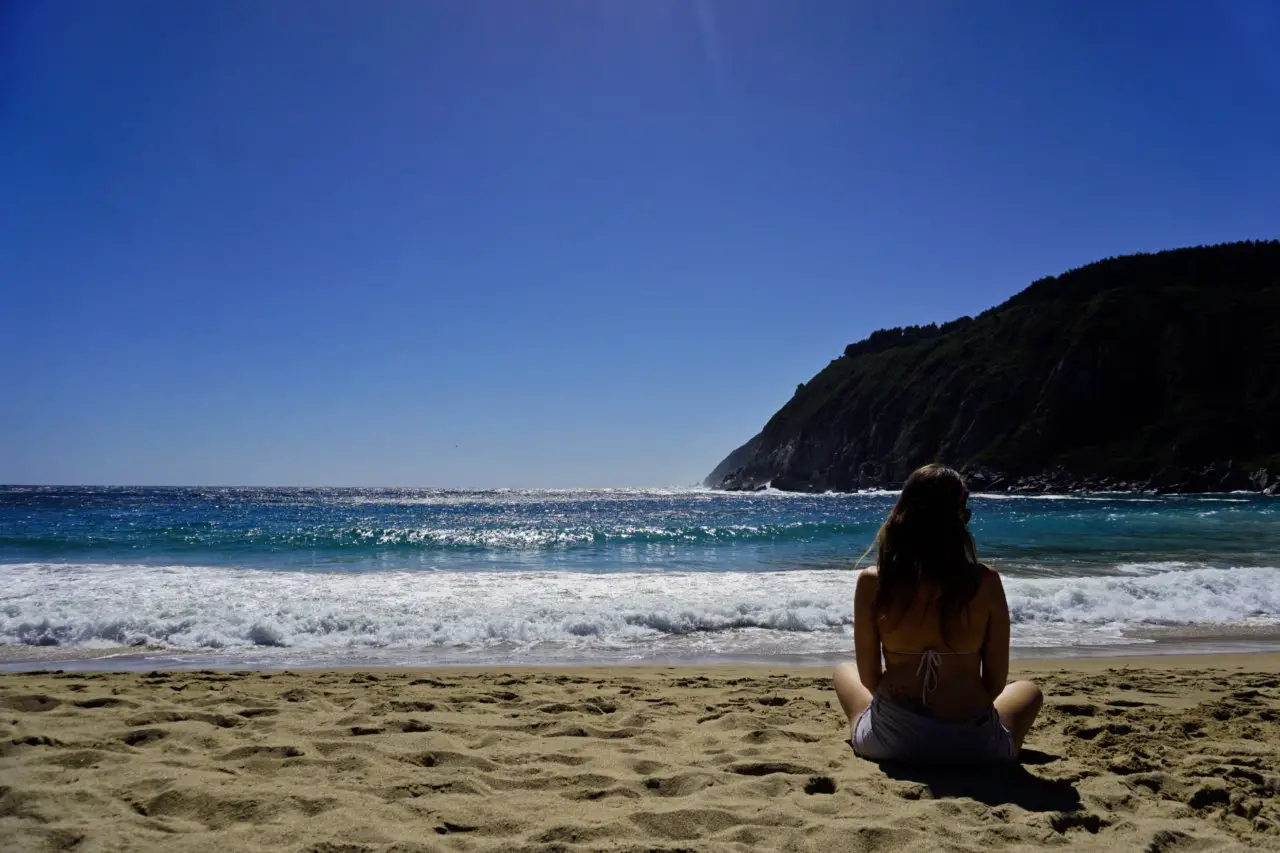
Take quick (ideally cold) showers
By Mitch from Project Untethered
I used to be a big dumb water waster. But after living in Cali, Colombia for a few months, I started to notice something bizarre. I could hear my Colombian roommates turning the water on and off every couple of seconds while taking showers. I was puzzled.
Upon further investigation (i.e. asking), I discovered that they were trying to preserve water –not only to save money, but also to help the environment. Turns out, cutting your shower time in half means you’re using 2x less water and energy. I know, seems obvious, but I’d never considered it before.
From that moment forward, I decided to start being more like my Colombian friends. Now, wherever I travel, I take 3-minute cold showers. The cold water wakes me up, I waste less time, and most importantly, I minimize my negative impact on the environment.
Don’t take selfies at places that have sensitive history
By Nabiha from Verses by a Voyager
One of the common issues we see nowadays, and which must be rectified, is the lack of respect of some travelers towards many places in the world. Unfortunately, it has become very common for people to take photos everywhere and many of those tend to disrespect the integrity of the place.
We have come across selfies taken at Auschwitz Concentration Camp, which I believe isn’t ethical. With so many lives lost at the camp, it must be a place to show respect. Same goes for religious sites. It’s very important for travelers to understand that respecting the place they’re visiting is an important part of traveling. Not every place is apt for photography and celebrations and travelers should always mind that.
Don’t feed the wildlife
By Rai from A Rai of Light
I first began to question the idea of feeding wildlife after witnessing the feeding of the flamingos at Aruba Flamingo Beach. Sure, they may have seemed comfortable, but something felt off.
It may seem like you are helping the animal survive and you may think you are forming a connection with the animal in the action of giving them something to eat. However, there are numerous reasons why feeding wildlife is a bad idea overall.
Animals do not need food from humans to survive. They have specialized diets that have evolved over millions of years and have the survival instinct to thrive in the wild. The food we eat is not healthy or nutritious enough for animals. If fed the wrong foods they can get sick, become malnourished or die.
Animals accustomed to people lose their natural fear. Feeding can lead to animals becoming too comfortable in residential areas potentially leading to aggressive behavior. Too many animals gathering in one place can cause injury or spread disease as the wildlife gather for food handouts increasing the competition and crowding.
I urge you to consider these consequences the next time you think of feeding an animal nearby.
If you travel with a baby, switch to cloth diapers
By Dani from Diapers in Paradise
Have you considered bringing cloth diapers to your vacation instead of disposables? A lot of parents dismiss the idea of using cloth diapers as too much work or too gross, but the truth is that they are neither of those things. With an all-in-one style like the popular BumGenius Freetime, cloth diapers work just like disposables, except they don’t go to the landfill. And especially if you are traveling to a developing nation, that is a huge deal.
How can you manage cloth diapers while you’re traveling without a washing machine? First, bring flushable diaper liners, which are thin like toilet paper, to catch any solid waste. But don’t flush them – most septic systems can’t actually handle them. Drop the solids into the toilet and then throw away the liner.
Then you’ll need to wash the diapers. To avoid using a lot of extra water, toss them into the bottom of the shower. Let the water run over them when you shower, occasionally wringing them out. This won’t get the diapers 100% clean, but it will wash out a good deal of the urine. After the shower, the diapers are ready to be hand washed and then hung out to dry and sanitize in the sunshine. While this routine is not ideal for long term use, it will get you through the trip and back home to give the diapers a more thorough cleaning in your laundry.
The average 6-month-old baby will go through 120 diapers over the course of a 2-week trip. That’s 120 diapers that will spend the next 500 years in the landfill of the place that you are visiting. Making the switch to cloth when you travel –and keeping it up when you get home– will make a major impact on your contribution to the environment.
Be sustainable at your destination
Be a responsible giver
I know how weird this might sound but stay with me. Most travelers, with the best of intentions, bring sweets, toys or clothes to give away when visiting a developing destination. Some give money to beggars, again, with their heart being at the right place. Unfortunately, these actions often hurt more than they help, since they encourage the habit of begging and create a culture of dependency.
If you’re staying with locals, by all means, bring presents for them. But otherwise, be careful. A better way to help is by buying locals goods. Although handcrafted souvenirs maybe be more expensive than the Chinese ubiquitous ones, they will make a much better memory, they’ll have superior quality, and you’ll be empowering the local community. Just keep one thing in mind: never buy wildlife products. When you do, you’re unconsciously helping to create an unethical marketplace, one of trafficking wildlife, many times endangered or becoming so because of this practice.
Another way is to give to a local organization that work on social welfare programs, or even better, to volunteer in the local community.
Eat locally
This is quite straightforward – by buying locally produced and seasonal food you’re not only helping the local community, you’re also getting a healthier and fresher product, and for less money. So skip big restaurant and supermarket chains, and head for locally owned restaurant, food stand or markets instead.
This will also give you the opportunity to immerse even deeper in the local culture, since food is a big window into traditions and customs. My experience in Iran wouldn’t have been as amazing as it was without the hundreds of cups of tea, or the delicious koshke bademjan I was lucky enough to enjoy with locals. Same goes for khinkali in Georgia. A trip to Brazil wouldn’t be complete without trying caipirinha. A visit Morocco has to include mint tea and tagine. I mean, who would prefer to go for McDonald when you can have a beautiful local meal instead?
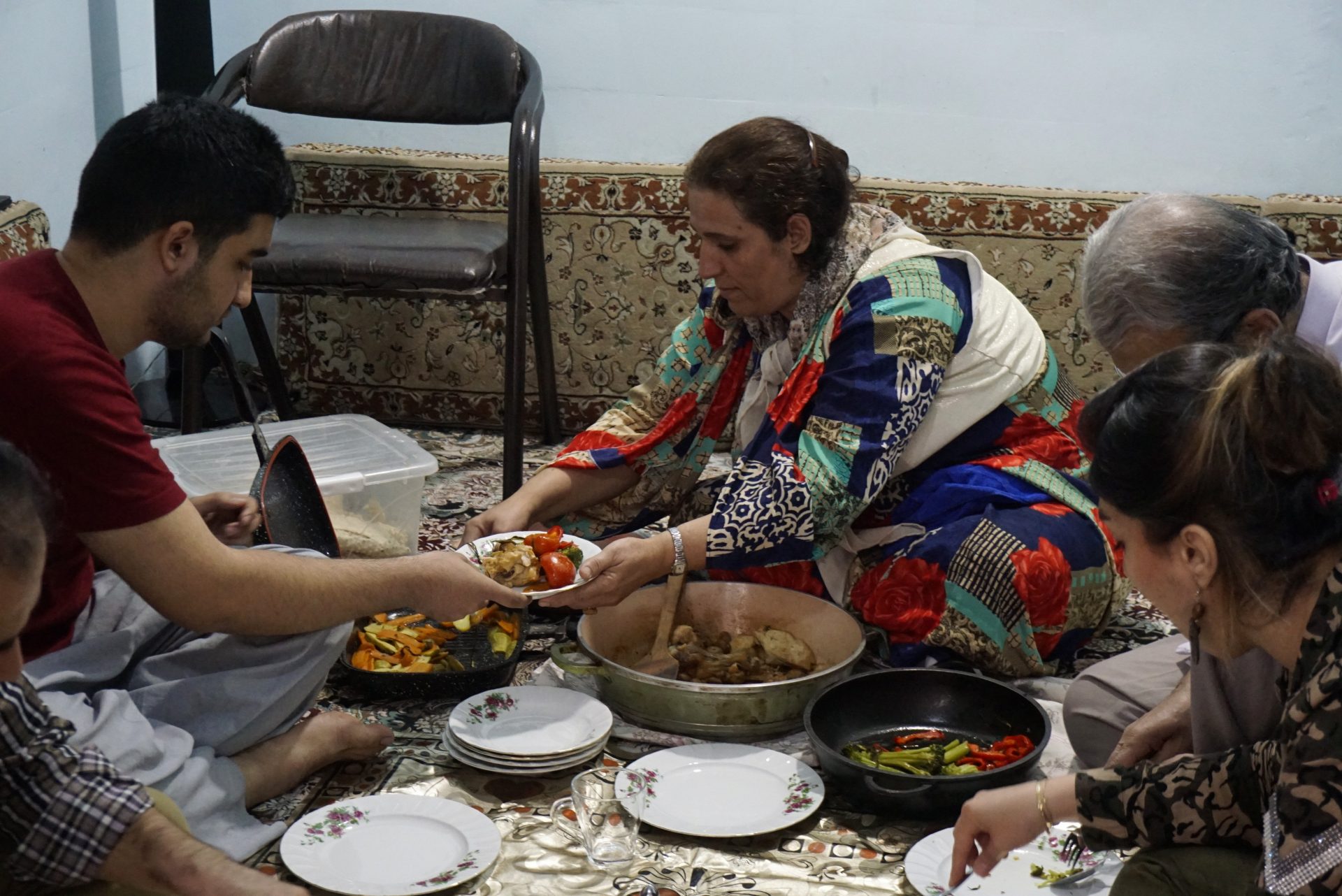
Take tours with local companies
By Katy from Untold Morsels
While increased globalism has made it easier for us to travel, often the profits and economic benefit of tourism is felt thousands of miles away from the destinations we visit. Help to contribute to the communities you meet on your travels by taking a local tour.
Joining a tour means you not only assist in supporting the people you meet, but chances are you’ll learn about the history and culture of your destination and discover some new perspectives. Forget a flag following crowd of selfie takers, tours these days are fun and engaging. They can even be tailored to your interests.
We love food tours where you visit producers and restaurants and try local specialties. You’re sure to meet some interesting characters that will open your eyes to unique flavors. On a food tour in Rome we tasted ancient artichoke recipes and a unexpected dish that is favorite street food of the region. And now we can recreate those flavors home along with the recipes that were shared and our memories of an incredible trip.
Don’t do animal tourism
By Michelle from Full Time Explorer
It seems everyone wants an “instagramable” moment with an animal on their vacations. The problem is that most people don’t realize what goes on behind the scenes before you have one of these experiences. It’s so important to look into animal tourism and avoid contributing to it. Cuddling a tiger or riding an elephant are not natural experiences and everyone should ask themselves what a trainer has to do in order to get these animals to submit. I visited an elephant sanctuary in Thailand where we learned about the horrible conditions in which elephants are trained. They’re tortured for weeks as babies while being held in isolation. A little bit of research will turn you off of participating in these activities.
Luckily, there are some amazing people out there who are working to rescue these animals. For instance, there is the Elephant Nature Park in Thailand where you can go and spend a day learning about them and even go swimming with the elephants. These animals have been rescued from tourism or the logging industry. Sadly, they can’t be released into the wild, but they do get to live on a beautiful sanctuary. The elephants are given the option to walk with tourists who feed them lots of bananas as a reward. They’re never poked, prodded, or yelled at. If an elephant doesn’t want to participate, it simply goes off into the jungle and returns when it wants more bananas. Having a respectful experience with animals is such an important part of sustainable travel.
Avoid day trips to overcrowded cities (stay there longer instead!)
By Alyse from The Invisible Tourist
Have you ever thought about staying a few nights at a popular tourist hotspot, rather than just skimming over it in one day? One of my favorite sustainable travel tips is to avoid contributing to overtourism by skipping day trips to overcrowded cities. And by this I mean staying longer there instead.
I’m sure you’ve seen in the news that many destinations around the world are suffering from issues caused by unsustainable tourist numbers. Lying at the heart of this issue is the volume of day-trippers to already busy destinations such as Kyoto, Venice, Santorini, Cinque Terre, Barcelona, Dubrovnik and Bruges. I’ve witnessed first-hand most day-trippers heavily burden these cities as they simultaneously rush from one place to the next in their short time frames.
Popular attractions are packed, crowded streets are difficult to navigate. Generally, day-trippers spend very little money in these cities. Locals breathe a huge sigh of relief as the sun begins to set and day-trippers head off to their night’s accommodation elsewhere.
Obviously, these cities are popular for a reason –stunning architecture, incredible history, amazing scenery and more. They’re at the top of many traveler’s wish lists with good reason.
So, what can we do instead? The answer is to stay longer. But, how is staying longer at your destination a sustainable way to travel? Wouldn’t staying longer cause more issues?
In truth, staying longer at your destination means you’re able to visit the popular attractions before or after day-trippers have left, therefore diluting your tourist footprint. Your money goes directly back into the local community and hotels rather than large chains out of town. The added bonus is the ability to peer behind the touristy curtain of a destination and experience more of its true side –without the crowds!
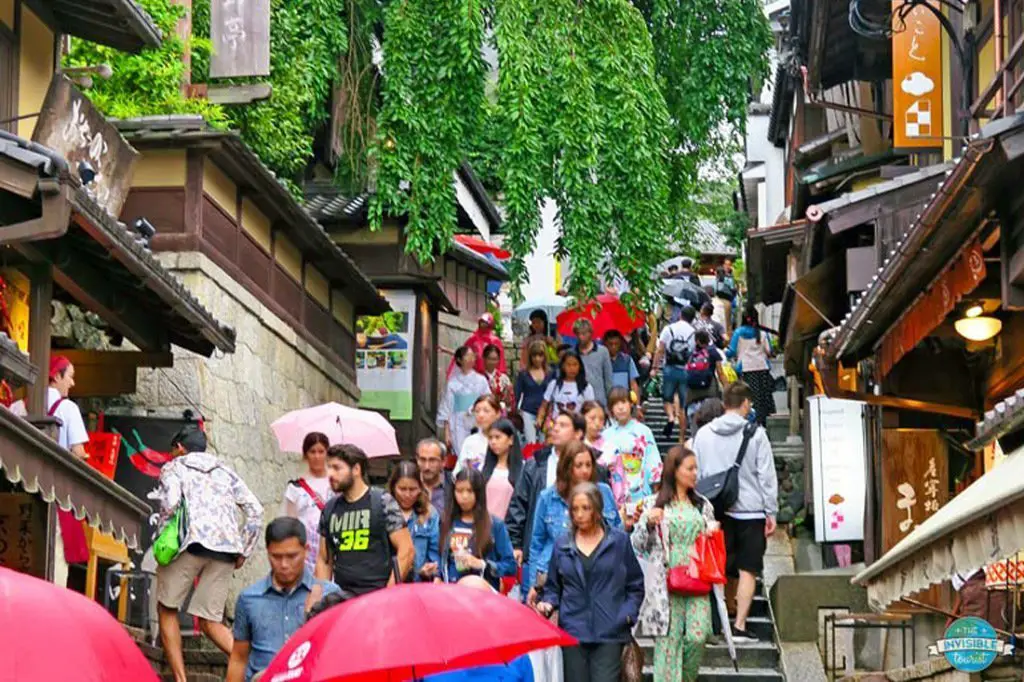
Put the “do not disturb” sign on the door
By Bret & Mary from Green Global Travel
From always carrying a refillable water bottle and turning off the water while you shave or brush your teeth, to refusing to use the hotel laundry service (which typically washes each guest’s items separately, even if there are only a few dirty things), there are lots of little things each of us can do to be more eco-friendly when we travel. But one of the easiest actions with the biggest cumulative impact is something even most ecotourism enthusiasts never consider. And once we learned this little trick, we started doing it every single time we check into a hotel room or resort.
All you have to do is to put the “DO NOT DISTURB” tag on the door for the duration of your hotel stay. This prevents housekeeping staff from entering your room to clean, which cuts down on the use of water and chemicals (to clean the bathroom and wash linens daily) and energy (to vacuum the floors of your room every day). And who does these things daily at home anyway? If you need extra coffee, shampoo/conditioner, towels, or what have you, it’s enough to ask at the front desk or call housekeeping. The amount of energy this one action can save can really add up over the course of a one-week stay.
Carry your own trash until you find a bin and pick up other trash
By Alex from Swedish Nomad
Trash is everywhere these days, and while it’s not always tourists who make a mess, it’s a good practice to carry your own trash instead of leaving it behind. The least you can do is to throw it in a bin.
If you want to take it one step further, you can always carry a trash bag and bring it back to your home where you can throw it in your garbage where you know garbage collectors will come and get it (and where you can recycle!).
Some places also have a problem with full bins out in nature, which leads to people just throwing it next to the bin. That’s when you should really carry it with you back home instead because it’s a clear sign that garbage collection isn’t working properly in that place.
A newer trend that has picked up by some is to always bring back more trash than you came to a place with. For example, you want to throw away 1 bottle, then pick up 2 other pieces of trash. Or even better, always bring a bag and pick up trash that you see out in nature. If we all do this together, there will be no trash left and it will definitely make traveling more sustainable.
Join or organize a beach clean-up
By Lena from Salut from Paris
If you ever walked along a beach, you know that between stones, shells and other flotsam, you find straws, parts of fishing nets and many plastic pieces. It’s always a good idea to just pick up any trash that comes your way. If you appreciate a community feeling though, check if your travel destination has a local Trash Hero group! This organization operates worldwide with many local activities and events. The Trash Hero group on Koh Phangan in Thailand, for example, organizes a beach clean-up monthly.
Once a month, a group of volunteers –usually tourists and locals– meet at a beach and very simply they clean it up! The organization provides trash bags and gloves and often a nearby restaurant donates some fruits and drinks for the helpers.
Many of the local groups are having Facebook pages to organize their events. Just search for Trash Hero and your next travel destination and get all information regarding upcoming events, meeting points and news. Or start your own group!
Stick to the trails
By Emma from Small Footprints, Big Adventures
One easy but important way to travel more sustainably is to be respectful of marked trails. Sticking to the designated areas while you’re exploring ensures that you don’t accidentally harm vegetation or transfer non-native seeds and bacteria to the location, and it also ensures you won’t disturb wildlife or damage the sites that you’re visiting.
Sometimes sticking to the trails is important for your personal safety, too. Ancient buildings are often crumbling, and they can be unsafe to touch or walk on. And natural sites can be unpredictable, so following the guided paths ensures that you’re walking along a trail tested by professional staff.
Unfortunately, I’ve witnessed people ignoring the trails in several places while traveling. At Uluru in Australia some tourists blatantly climbed behind a roped off area to get better photos, which was dangerous to them and could have damaged the rockface. At Angkor Wat, many areas were roped off due to instability, and yet a couple of tourists still ventured into the crumbling brickwork. Please don’t be like these irresponsible people. No photo or daring experience is worth ruining an irreplaceable piece of history or risking your life for.
RELATED POST → Eco-friendly hiking: sustainable tips and packing guide
Avoid geotagging exact locations
By Trish from Keeping it Curious
Being in nature and taking pictures with or of it is often a double-edged sword. While it may be tempting to immediately geo-tag the exact location of a beautiful place you spotted, it usually has disastrous effects on the environment. Many studies and environmental scientists have started to advocate against using the #nature tag on Instagram, for example.
The issue with nature shots is that the places frequently are unprepared for a sudden influx of people. It usually means destruction to the natural ecosystem surrounding the “perfect Instagram shot” in addition to a lot of leftover garbage. One example was when a person with a huge number of social media followers took a beautiful shot in a field of sunflowers. Suddenly, thousands of people were flooding various sunflower fields (usually trespassing). Many farmers had to release public statements urging people to stop as it was destroying their crops.
Therefore, it is important to realize the hard line between being the first person to uncover the beauty of nature and exposing these places for everyone to see. If you decide to visit a very popular nature spot, perhaps consider shooting from a different angle. This can help decrease the pressure of the very small spot of land that is usually the most popular. If you discover a relatively hidden gem, try to keep the place you took the photo as vague as possible. It is ok to mark a public park, but avoid tips such as “stand on this particular log and you will get the best photo in the park”. Above all else, please keep the place clean, pick up after yourself, and consider picking up after others too.
Ask questions and leave feedback
By Eloise from My Favourite Escapes
It’s easier to make sustainable travel choices when operators are on board and implement actions to reduce your footprint. But they may need a little push and encouragement from travelers to get started.
My sustainable travel tip is to ask questions and leave feedback to the operators you traveled or stayed with. First, it shows them that travelers care about sustainability. When operators will feel that sustainability is important to increase their number of bookings, it will give them an additional reason to look at it, and it won’t be seen as just an effort but as an opportunity.
Second, they may feel proud to share their sustainable efforts and see them recognized. And if you picked up something they should be doing better, maybe it will help them improve their operations. When we traveled to Vanuatu and New Caledonia, we met a couple of operators who, when they saw our interest in sustainability, asked us to provide tips. It was an interesting exchange.
Finally, nothing stops travel operators from auto-naming themselves as eco-friendly. If there’s no label to verify their credentials, they may be green, or they may be greenwashing. So your questions and feedback can be important to support the good operators out there, and call out the ones that should be doing better!
Ask tourist guides not to interact with the wildlife
By Shimona from Sidecar Photo
When I take a guided trip to see wildlife, I scour the reviews to try to find guides that do not feed the animals, leave trash or do anything otherwise unsustainable during the tour.
I did this on a recent tour to see orangutans in Sumatra and found a good guide. But, on our tour, when we encountered a particularly aggressive orangutan, Mina, he fed her.
Now, I know he had to do everything he could to keep us safe, but I also know that Mina is semi-wild, stays in the same location, and is consistent in her behavior. I would have been okay with missing out on seeing her at all, because it almost always means that the guides have to feed her. She’s pretty much learned that she can bite people if not fed.
In retrospect, I wish I had told the guide upfront I didn’t want to see or feed Mina. He’d told us already that it’s not good to feed them or get close so it wouldn’t have been hard to clearly let him know we felt strongly about it too.
The guides are only human and don’t want to disappoint their customers. They have to gauge where you stand on these things, as much as you have to gauge them. Except they don’t have reviews of you.
I realized you can help them by letting them know where you stand, so they don’t have to guess and it also reinforces to them that customers prefer sustainable behavior. If more customers state clearly they don’t want to tradeoff good practices for the best photos, they will take it to heart.
The jungle and these animals are their livelihood after all, and it’s in their best interests to protect them. We just need to let them know we want to protect them too.
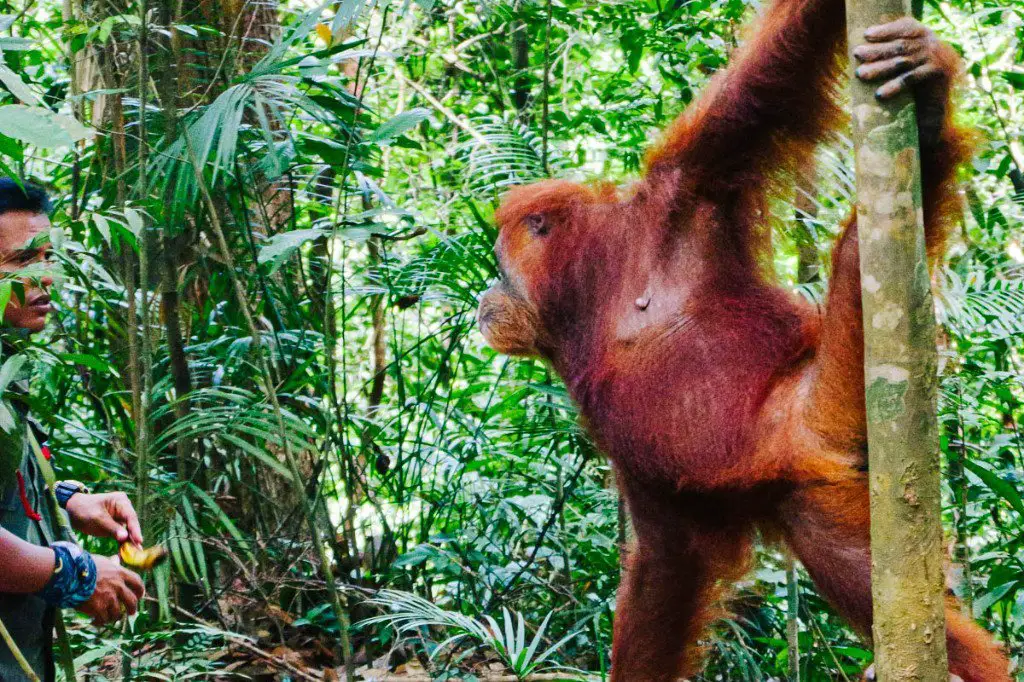
Sustainable transportation
Fly less
Cutting down your flights has a significant impact on you carbon footprint, so whenever possible, choose any other means of transportation. I know that’s not easy, especially when you’re traveling long distances (I mean, I travel from Europe to Chile about once a year :/). But when you’re going to a place nearby, even if the temptation of grabbing a quick flight is always there, consider a train, which is much more sustainable.
Now, if you must take a plane, you can carbon offset your flight. The easiest option is to tick the little ‘carbon offset’ box when you book your next flight. But don’t do that. Go to an NGO like Gold Standard instead. In any case, by giving a small donation your emissions will be compensated for. The money raised will go to projects on renewable energy or conservation, or to tree planting. [If you offset through the airline, they will use the money donated to reduce taxes, so it’s better to go straight to an NGO].
Another way of helping the environment is to choose non-stop flights instead of one with stopovers. This is because the takeoffs and landings are the times when most of a plane’s carbon emissions are created.
It also helps to fly low cost. Yeah, you read that right. Budget airlines squeeze more people in, they don’t give food to passengers, and most of them even skip the heavy and shiny magazines you find in front of your seat when you fly with bigger companies. All of this means more people being flown and less overall weight, which equals to a smaller individual carbon footprint.
Finally, a good practice is to keep your trash, especially if it’s plastic, because you’ll be able to sort it correctly and recycle it –something most airlines still don’t do.
Travel by train
By Ellis from Backpack Adventures
We all know that flying is bad for the environment. Sometimes there is no other way, but I try to travel sustainable by flying as little as possible. Because cars and buses also emit a lot of carbon, my preferred option is the train. Besides walking or cycling, taking the train is the most environmentally friendly way of traveling.
It would be hard for me to justify taking a short flight or a long bus journey when you can also travel by train. The train might take more time but it’s often cheaper and more comfortable. Furthermore, it’s a great way to meet local people and you get to see the landscape of a country in a different way.
Over the years I have developed a great love for traveling by train and I have lots of fond memories. One of the most scenic journeys was the Kandy to Ella train in Sri Lanka where I could see a beautiful sunset over the tea plantations. Another scenic journey was the Dogu express from Ankara to Kars in Turkey. In 24 hours I crossed the Anatolian highlands to the remote northeastern corner of the country.
My most recent trip was to central Asia, and especially Kazakhstan and Uzbekistan were perfect to explore by train. The distances are huge and by crossing the empty steppes for hours I could get a real sense of the vastness of these countries. I also experienced true hospitality as people shared their food and drinks with me. Traveling by train is never boring and I always come home with interesting stories.
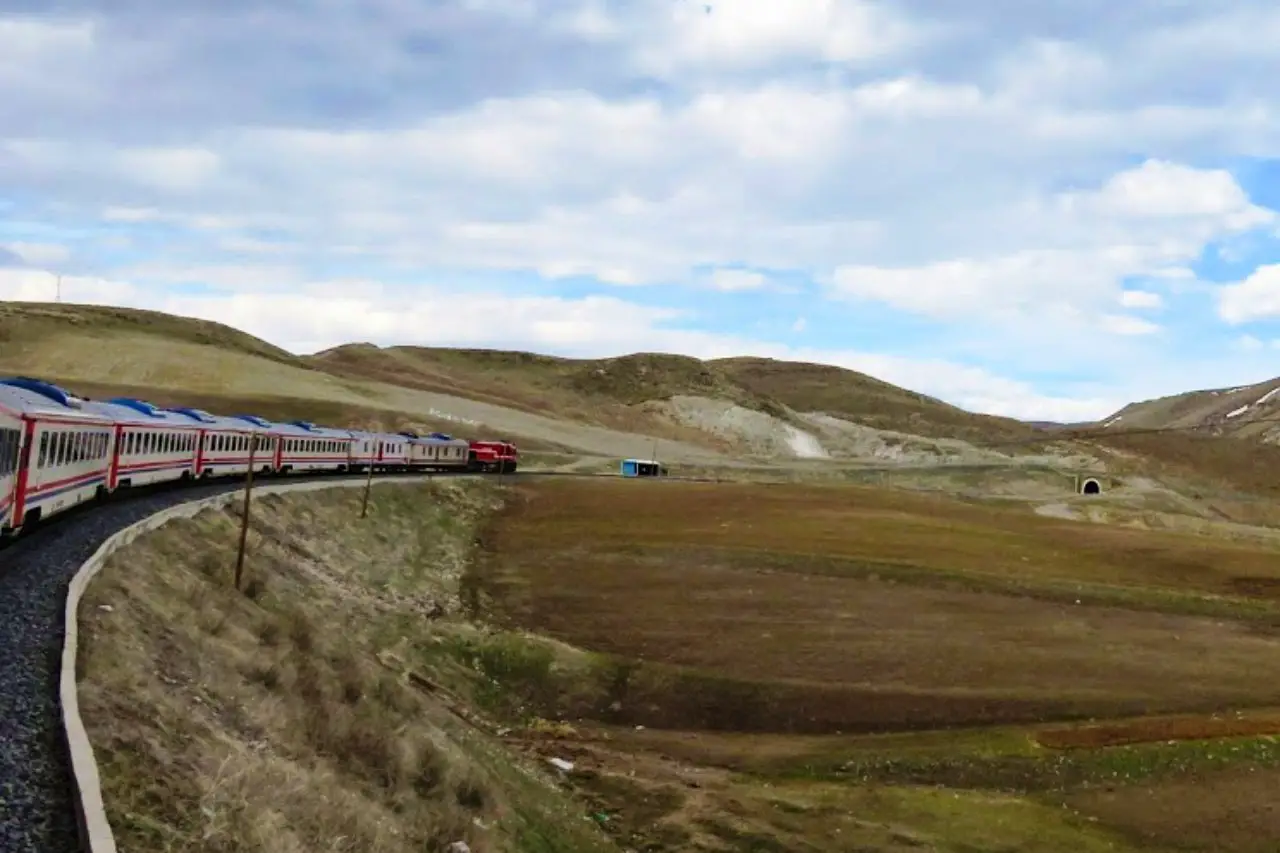
Bike touring
By Eniko from Travel Hacker Girl
Reducing air travel has one of the biggest impacts on the environment. Giving up travel completely would be very difficult for most people. But there is so much to discover close to us as well. Traveling by train is very convenient and effective nowadays. There is good rail link in all of the UK and mainland Europe. It is also a great way to go bike touring. You can take your bikes on most trains, often without extra charge. Bike touring is a fantastic way to travel slow and really immerse yourself in a country. You will not only see the big cities and attractions but the countryside as well and how the locals live.
There are 16 EuroVelo routes covering Europe, but most other continents also have a network of cycle paths for long-distance touring. The UK has a big National Cycle Network, many of them ideal for families as well, like The Viking Coastal Trail. Bike touring is also quite affordable once you have the right equipment. You just need a bike, panniers, camping equipment and you are good to go. If you don’t fancy camping you can also book accommodation. There are many bike friendly B&Bs.
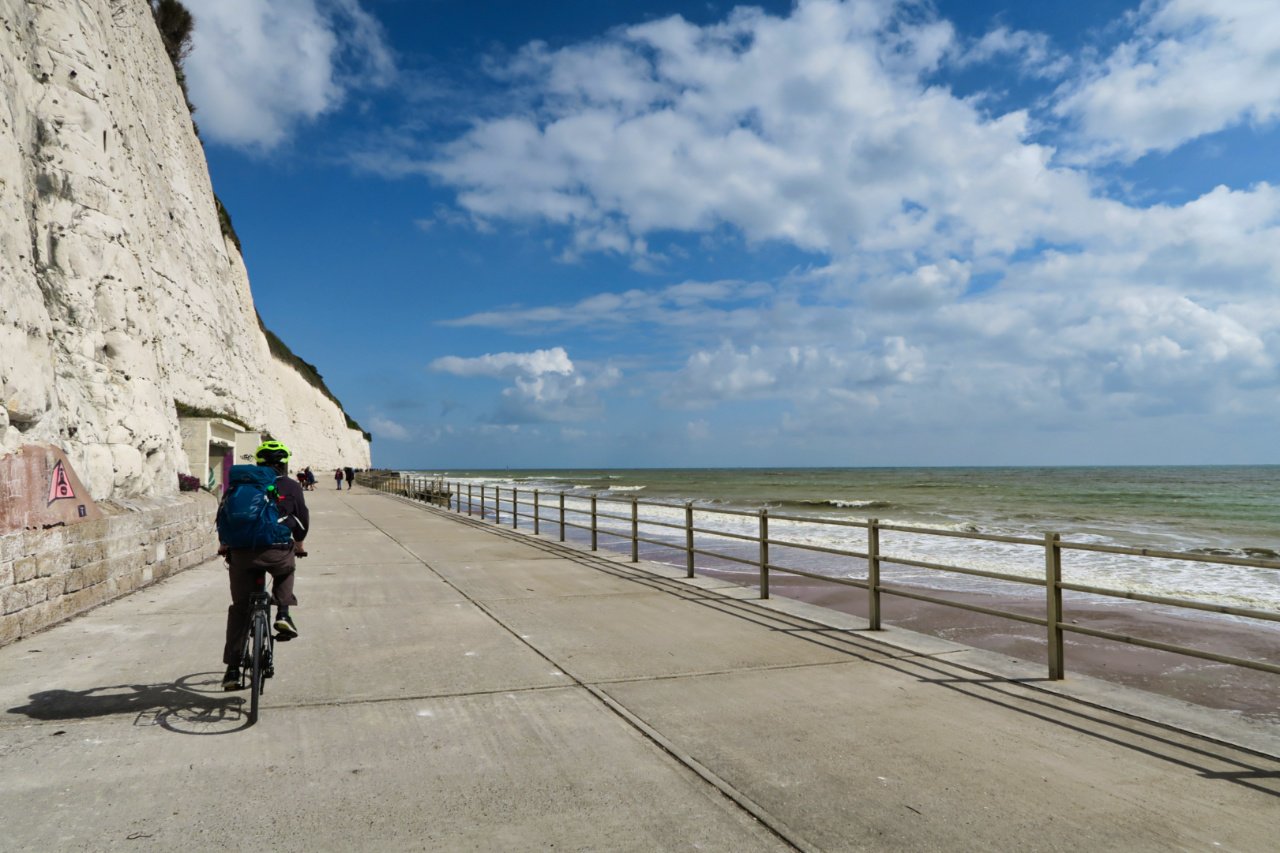
Walk
By Inma from A World to Travel
Whenever possible, embrace walking holidays. It was never easier nor more convenient to do so. Let’s take for instance the world-famous Camino de Santiago (Way of St. James) that takes pilgrims from every corner in Spain and beyond to Santiago de Compostela.
Once upon a time, it was just reserved for religion-oriented ventures, people had to sleep in shared rooms in spaced-out hostels (which meant stages were very long sometimes), and endure other things such as carrying their backpack even if they had serious back problems.
Not anymore, with lots of companies focused on making your Camino experience a better one. It’s now possible to sleep in boutique hotels, have your bag delivered at the end of your daily walk, or eat at world-class restaurants dotted along the way while keeping your carbon footprint as low as possible.
This goes for many other places. But even if it’s not more comfortable, keep in mind it’ll help the environment, and it’ll keep you healthier.
Travel by campervan/motorhome
By Kat from Wandering Bird
As a normal couple with a young daughter and busy lives, we have always felt under pressure to do everything FAST. Holidays were spent rushing around, trying to see the best of everything in the shortest time possible. We love to travel, but we often needed a holiday to recover from the one we’d just had! Sometimes it seemed like too much hassle.
Until we discovered slow travel. We decided to tour Europe in a motorhome, so we bought a cheap camper and used our holiday allowance to head off in different directions and explore as much as we could.
Because we were driving, we naturally took longer to get to places, but we also got a much better feel for an area, we met more people and we saw more from the road.
One night, up a mountain in Switzerland, we realized we had fallen in love with motorhoming and slow travel. We had become more conscious of water usage, rubbish, waste, plastic packaging – and worked hard to impact the environment as little as possible as we traveled.
We also found it a cheap way to live and realized that if we downsized our life enough, we could quit our jobs, sell up and travel for longer in our camper. So we did. We’ve now been exploring Europe slowly for 18 months, keeping our lives as sustainable as we can. And we love it.
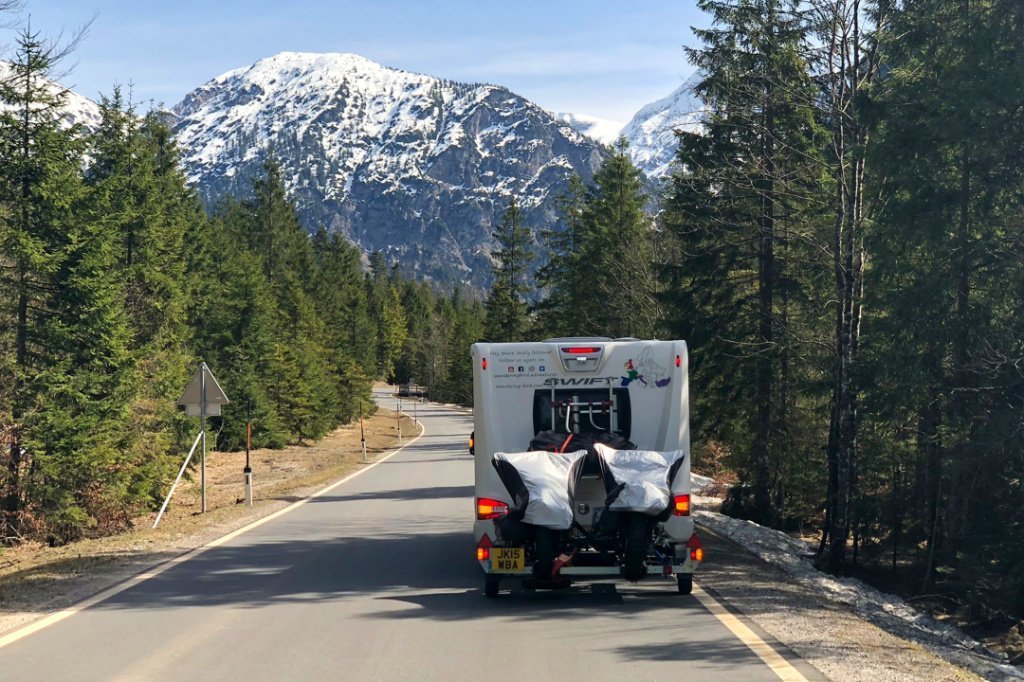
Go for group tours if you are solo or a couple
By Shalini from Eager2Travel
When you are traveling solo, as a couple, or with a friend, a good practice is joining group tours instead of choosing to travel alone (or just the two of you) in a car. It will help to reduce carbon emissions thus protecting our mother Earth. It also has the added benefit of being cost friendly.
Using public transportation is always a good option, but much harder when you are traveling to remote areas. If you’re renting a car, at least try to find a travel buddy (there are Facebook groups for this). If you’re joining a tour, go for a bigger group, not a private one. You’ll get to meet new people, make new friends and get great memories. We can all do our part to preserve this beautiful world, and this is an easy way!
Sustainable accommodation
Camp
By Stephanie from Navigating Adventure
In an effort to decrease our carbon footprint, my family has gone back to basics and taken up camping. We generally limit long-distance travel to once a year at most, and spend the rest of our holidays exploring our local region.
Saving money on flights and expensive accommodation meant we were able to purchase a good quality tent. We are not only having less impact on the environment, but we love the freedom that camping brings and are enjoying the very nature we are trying to protect.
Anyone can camp –you don’t need a 4WD, extensive equipment or experience. As we are usually just traveling with our son, we are fortunate enough that we can fit all our gear in our six-seater hybrid Prius (much to the amusement of our fellow campers). This helps us limit our luggage to what we really need. Roof racks are another way to fit your gear in if you need. Although it’s important to be comfortable, my best advice is to keep it simple.
Even when camping, it’s important to be mindful of making sustainable choices. Resect the environment and only camp in designated areas. Bring your food in reusable containers and don’t leave any waste behind. Don’t pollute local waterways or feed the wildlife. Only light fires if allowable, and ensure you put them out before going to bed. Take everything you brought with you and leave behind everything that belongs in the bush.
The best part of camping is disconnecting from our busy lives and devices. It’s easy to feel helpless with the state of the world, but immersing ourselves in the natural environment –only hours away from home– reminds us how lucky we are and why we need to do everything we can to protect this beautiful planet.
Stay in eco-resorts
By Jenny from TraveLynn Family
After flying, the travel choice that perhaps makes the biggest environmental impact is your accommodation. We always try to stay with independent, family-owned accommodation, rather than large, corporate hotel chains. In this way, we know that our tourist dollar is going to a local family, and in turn, supporting that community.
But this choice can be taken further by staying with accommodations that are taking steps to reduce their impact on the environment through sustainable waste and energy management, like some eco resorts in Europe. Many of these accommodations are totally off grid, sourcing their own energy from wind and/or solar, and finding their own water. Then on top of this there is a big focus on buying local produce and hiring directly from the local community.
For your next holiday, think twice about your accommodation before you book. An eco-resort doesn’t necessarily mean budget either. There are a good selection of high end eco resorts across the globe.
Ready to search for your next eco-accommodation?
Think twice about AirBnB in places that suffer from overtourism
By Linn from Brainy Backpackers
Overtourism is a huge problem all over the world. A lot of places experience overtourism all year round, like Venice, and other have seasonal overtourism, like where I live in Costa del Sol, Spain. During the summer months, there are so many tourists that it’s impossible for the locals to find a spot at the beach, to find parking, or simply to walk out of the house without meeting some drunk tourists walking around the streets in their bikinis. Consequently, prices have raised so that locals can’t afford life. Rental prices especially are sky rocketing, but the main problem is that it’s hard to find a flat for long term rental. Most landlords prefer to rent out short term through AirBnB in the summer months because they earn more on that than on a year with long term.
This is a common phenomenon in places experiencing overtourism. Locals slowly get pushed out from their cities as they can’t afford to live there anymore, or simply that they can’t stand the constant flow of disrespectful tourists.
To avoid contributing to overtourism you can try to put your holidays to the low or shoulder season, or you could visit alternative destinations. I totally understand that some bucket list destinations just have to be visited. But you can do your part by researching your accommodation, so you don’t contribute to pressure the locals. AirBnB can be negative in some places, like Barcelona and Amsterdam, as the locals are losing their homes to AirBnB rentals. In these cases, it’s better to book at a hotel or a hostel.
Avoid staying at overwater villas
By Rahma from The Sane Adventurer
Maldives is a tropical paradise and a dream destination for many people around the world. All the pictures of the stunning island country which are circulated on the internet show turquoise water, white sand beaches and luxurious overwater resort rooms to make the place look as dreamy as it could be.
However, there is a very dark side to the ever-growing popularity and luxury Maldives has to offer. Due to overtourism, the island businesses have doubled the number of luxury resorts in a small vicinity. As the overwater villas a great tourist attraction, even the smallest of the resorts have more than ten overwater villas at the minimum.
The issue here is these villas are built in the sea which negatively affects the marine life in the area. Dead corals are the biggest concern which has risen due to the industrialization of every single island in the Maldives. My recommendation for anyone planning a trip to the Maldives is to avoid staying in these expensive overwater villas and rather opt to book an accommodation on the local islands, which directly benefits the locals.
Sustainable travel photography
I decided to write this part myself because it’s really close to my heart, but it turned out to be much longer than anticipated, so I created a specific post for it. Follow the link to read the all my tips on sustainable travel photography.
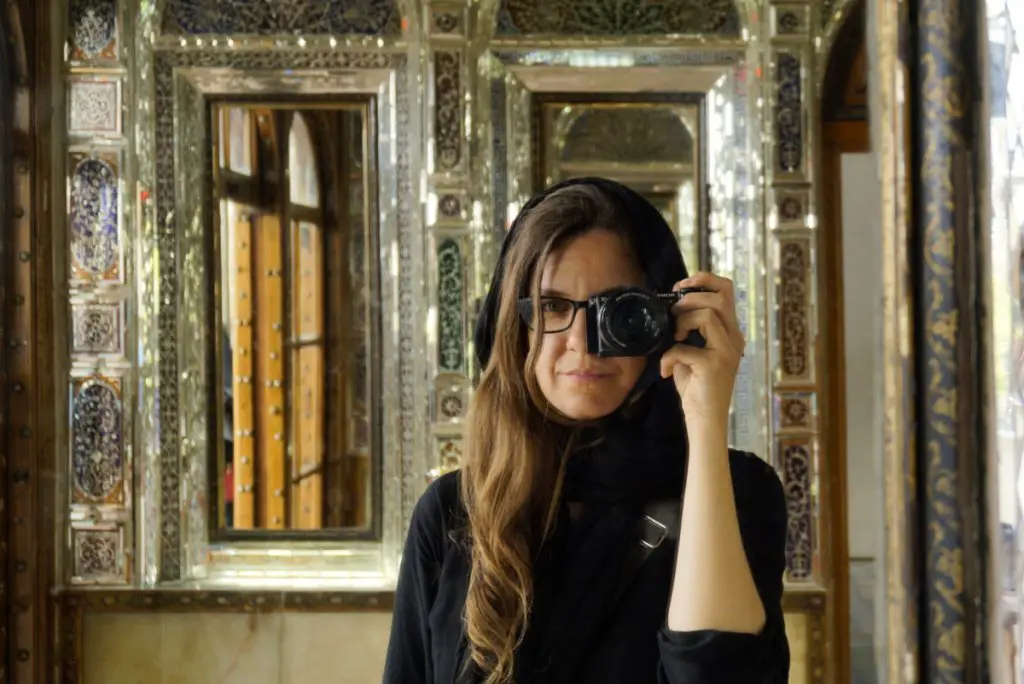
Bonus
An example: Copenhagen Sustainable Tourism Development Strategy
By Derek from Everything Copenhagen
In 2018 Copenhagen launched the first Sustainable Tourism Development Strategy called Tourism for Good. Their efforts are geared towards making tourism to Copenhagen part of the solution towards a global sustainable transition.
The efforts are targeting the tourism and hospitality industry, global businesses working in and visiting Copenhagen, and travelers themselves. Copenhagen’s aim is to set sustainability targets that will influence these industry standards. Secondarily, the goal is to show tourists how Copenhagen is making strides in sustainability and to encourage those behaviors abroad.
The Danish capital is targeting carbon neutrality by 2025. Some direct investments include expanding Copenhagen’s massive biking infrastructure and expanding the city’s metro. The Sustainable Tourist Development Strategy also plays a role in increasing bike rentals around the city and including public transportation in the Copenhagen Card tourist pass. Additionally, efforts are made to spread out tourist travel patterns. This is being accomplished through an increase in marketing travel to Copenhagen during non-peak travel months. If you’re wondering when to visit Copenhagen –any time of the year will be great according to Tourism for Good.
Overall, Copenhagen is leading the way in sustainable tourism through an effective, multi-pronged approach.
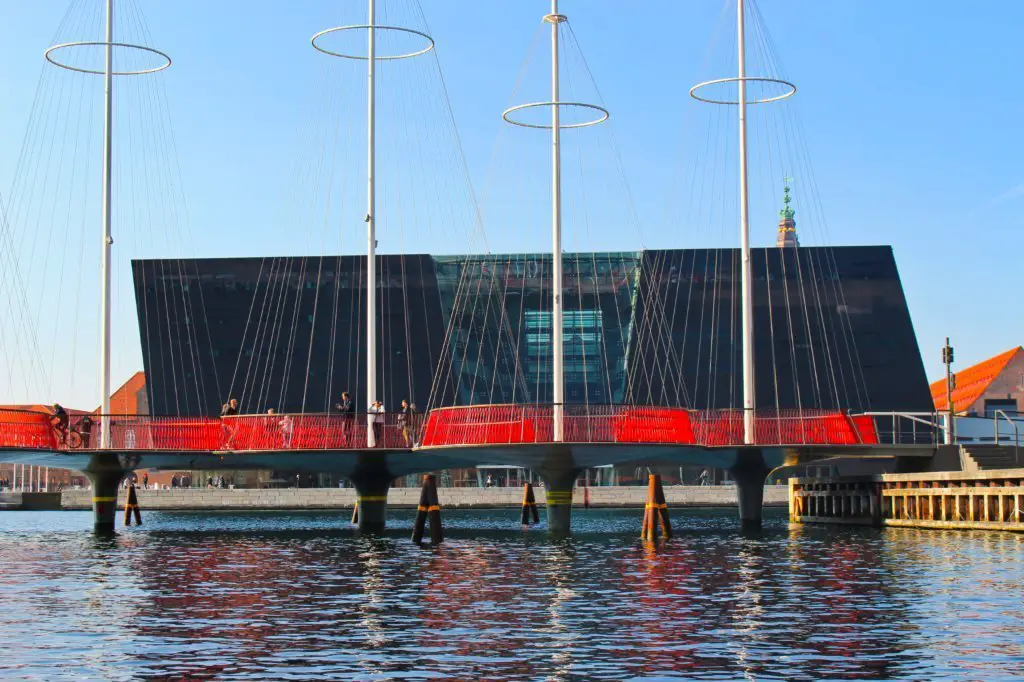
Are you doing your part? Did you get inspired to become a more sustainable traveler? Do you have an idea that’s not on this list? Please let me know in the comments!
RELATED POSTS:
- Eco-friendly hiking: sustainable tips and packing guide
- Sustainable Travel Photography
- Vegan travel: Sustainability and the most veg friendly destinations
Liked it? Want to read it later? Pin it!
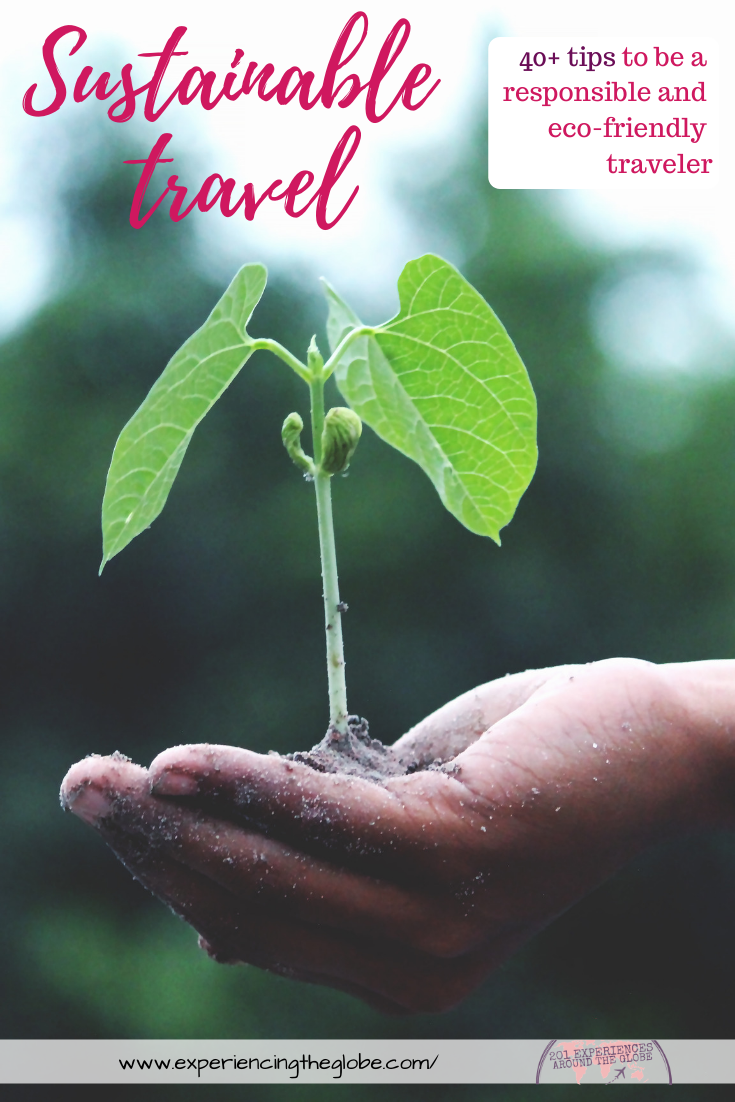
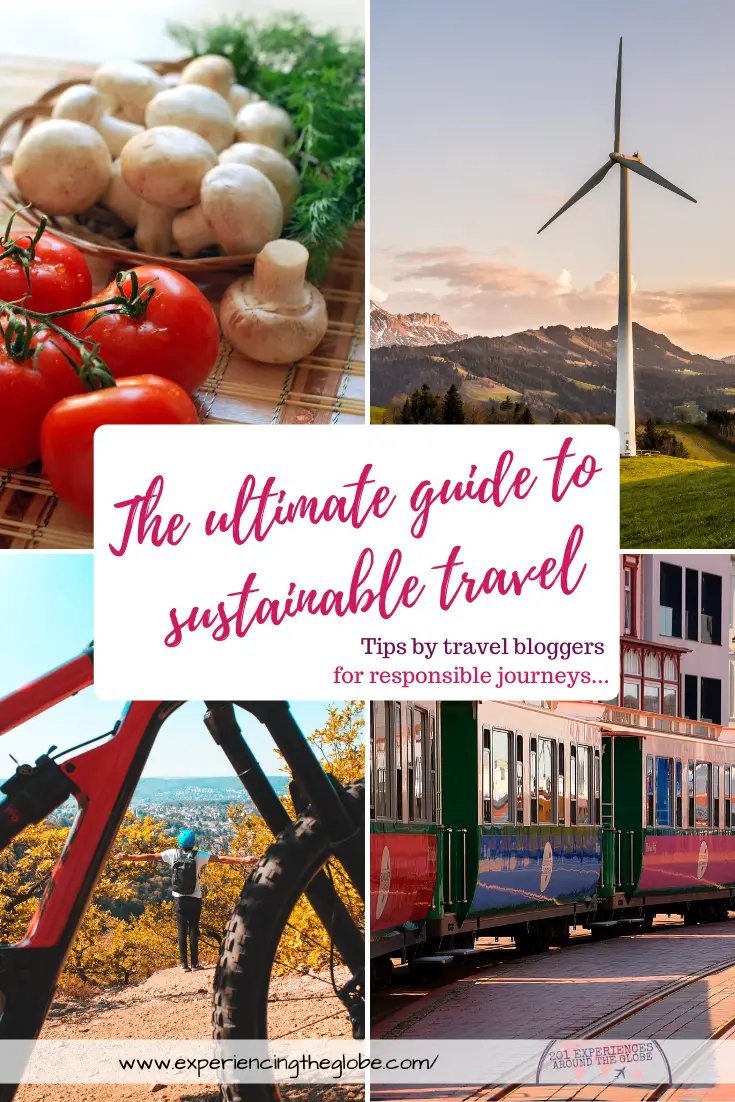
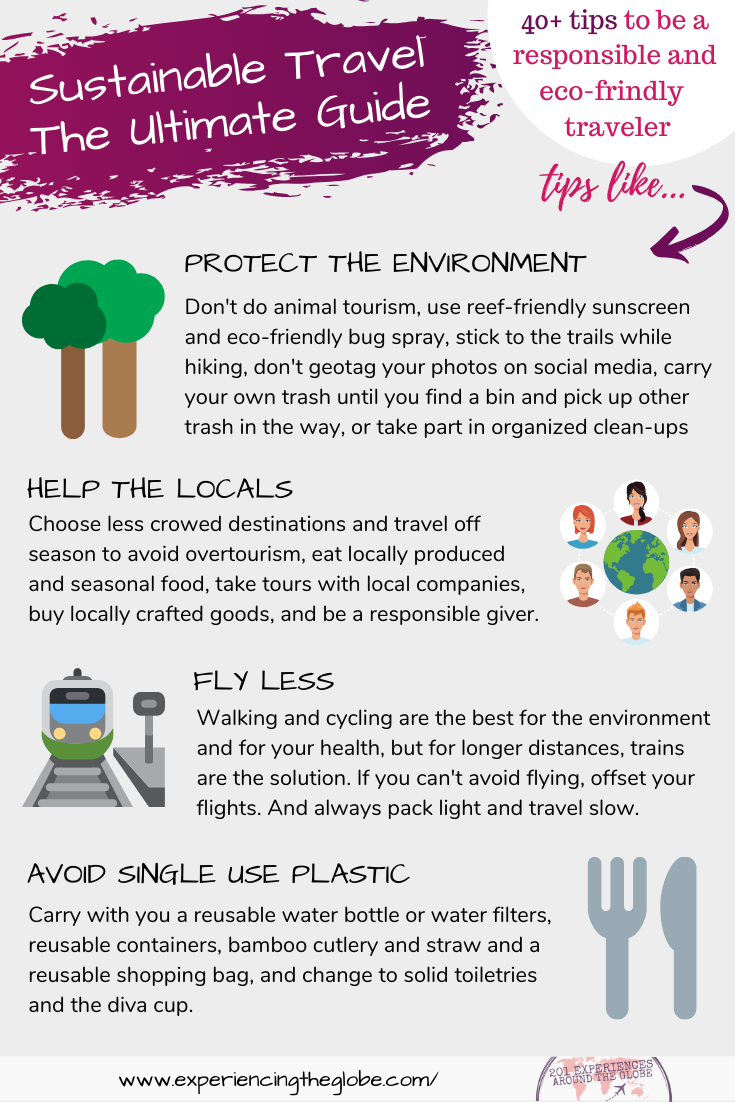
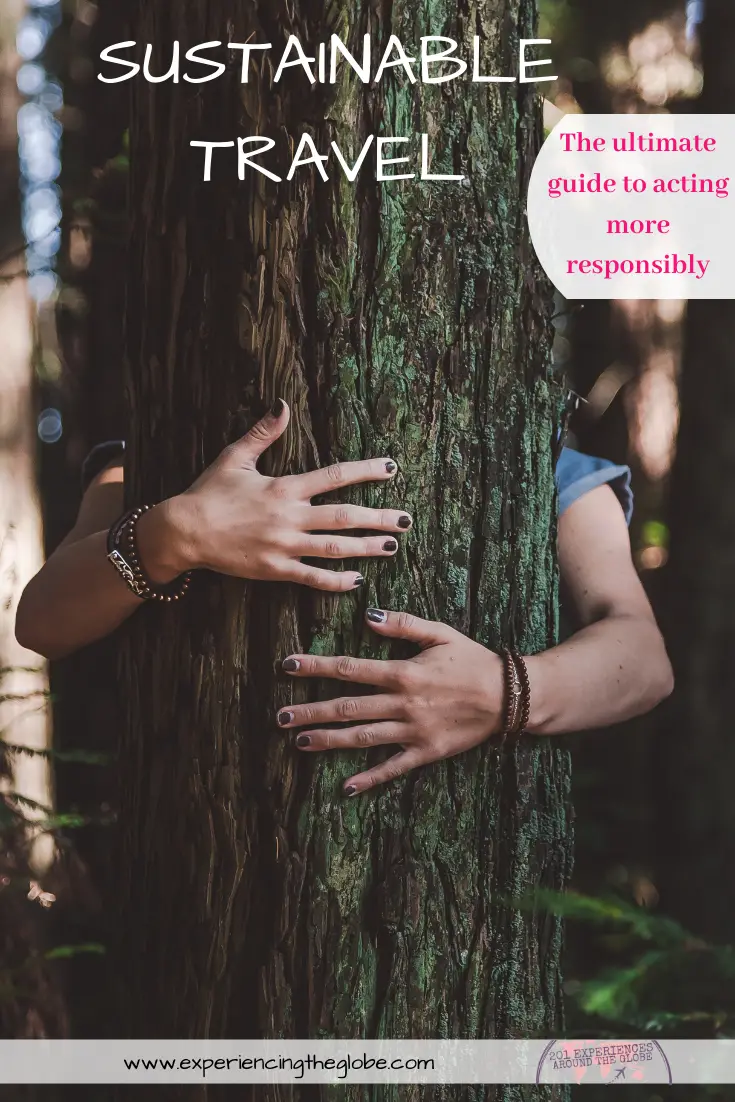
Enjoyed what you read? A lovely way to show your appreciation is by buying me a cup of coffee 🙂
Your support will ensure I keep bringing you stories and insights from around the world! Thanks so much!



This post offers valuable sustainable travel tips that are especially crucial for regions like Annapurna and the Everest region of Nepal, where minimizing waste and carbon footprints is essential for preserving these fragile ecosystems and ensuring their beauty endures for future generations.
This post offers great tips for sustainable travel, and it’s a reminder of how important it is to reduce our carbon footprint, especially in places like Everest Base Camp, where we can work together to make it a more eco-friendly zone and preserve its beauty for future generations.
OMG! Who knew there’s so much we can do to be sustainable travelers!? I’m so glad I found this post. Thanks so much for sharing! I already ordered a reusable water bottle, and I’m looking into changing my future travel plans to use more trains. This was so eye opening. Really, thank you!
I’m so happy to hear this, Karla! You’re most welcome! Even small changes help out a lot, so don’t get overwhelmed, you’re on an excellent path, keep it up!
So many important tips here! I’ve never stayed in an overwater villa, and hadn’t even considered it could be problematic if I ever did. So much to think about when you’re out there in the world!
It’s crazy how things we are used to can be harmful. The overwater villa was also something I’ve never considered before, same as chemicals in sunscreen, yet they can destroy a whole ecosystem! The good news is that more and more people are taking an interest in being more sustainable, so there’s hope!
I am still struggling with implementing some of these but its always good to be reminded what we can do better. I need to try one of those menstrual cups hahaha
They sound like a pain, but, trust me, you get use to them, and the amount of non-recyclables (and money) we save is huge! Absolutely worth giving them a shot 🙂
This was so helpful! I would love to be a more sustainable traveller but I’m such a newbie to learning about this stuff, I don’t know where to start haha. Thank you for this!
Start by changing something simple, like carrying a water bottle, and add a thing or two to every trip. In no time you’ll be super sustainable 😉
What an inspiring post! I definitely picked up a few tips and I am happy to say that I do follow many of these practices. I also do a lot of business travel and I think it is important for those who travel a lot for business to use the Do Not Disturb more often. I do it and I feel like I am in the minority!
Thanks so much, Andi! I’m happy to hear you do your part, and happier to see that you’re willing to go for more ❤️
Superb! Very much detailed and environment-friendly. I wish everyone would do the same. 🙂
One action at the time, and slowly slowly we’ll be making the world a better place 🙂
This is such a well written post! We are currently trying to do our part to travel more sustainable and that means we are bringing our own water bottle and shopping bags with us wherever we go! Also, my favorite thing ever is shampoo bars and I have been using them for years! Thanks for sharing all your great tips!
I recently converted to solid toiletries, and it’s amazing how you can’t notice the difference while using them, and they make traveling more comfortable. Isn’t it amazing when you can help the environment and solve a problem at the same time? 🙂
So many amazing tips! It’s so important for us as travelers to do our best to travel sustainable and support the earth that we’re traveling to see.
It really is! As travelers we have a huge responsibility to take care of the planet we want to explore, and some times we’re not even aware of the consequences of our travels. But there’s so much we can do!
This is such a great collection of amazing ideas. I’m definitely going to try to be more conscious of some of these things. As a vegetarian who doesn’t go anywhere without my metal straws, water bottle and reusable cloth bags I’m always trying to be a more sustainable travel, but love some more of these ideas on how to be better
You’re off to an amazing start! Only being a vegetarian gets you far into the sustainable game. I’m sure it’ll be easy for you to add an advice or 2 more into what you’re already doing 🙂
Great tips! I had never considered a lot of them (walk more, pack less for example) but they really do make a lot of sense. Thanks for the eye opening piece.
I’m so glad you see it that way! One change at a time, and we’ll be living in a better world 🙂
To be honest, many of them I really cannot do it…. but at least good to know, and some of them, I will try my best to follow, coz I do want to be more sustainable (let’s say contribute a bit as I can).
“Walk” and “travel in off season” is a good idea, btw 😀
Even though the more, the better, if you only follow a few of these tips, you’ll be contributing. Besides, when you start trying, you become more aware and other behaviors start to change 🙂
Amazing advice! Your post is super informative and detailed. I love how more people are become conscious that they way we travel is pretty much destroying the planet. Thank you so much for sharing this super important subject!
Thanks so much, Pauline! I know it’s a subject super close to your heart, so it’s great to see you loved the post ❤️
There is so much that can be learned from this post on how to not only travel, but live sustainably to help the environment and reduce waste. Love the idea of the Scrubba bag and water steriliser in particular!
I’m so happy this post is having a positive impact on fellow travelers! We all care about the world (that’s why we travel, right?), so I think we’ll be the first to take an extra step to help make it a better place!
What a brilliant, thorough post! I consider myself someone already very concerned with sustainability and ethics when travelling, but I still learned some new things from reading this – I didn’t know about the problems with the overwater villas, for example. I also love the Scrubba laundry bag – hadn’t heard of it before and think I definitely need to get one. This is such a good guide for anyone looking to travel in a more sustainable way (which is hopefully most people nowadays!).
Thanks for your lovely words, Rachel! Putting this post together was amazing for me too -I’m really worry about sustainability and still I learnt a lot from research and from my fellow travel bloggers 🙂